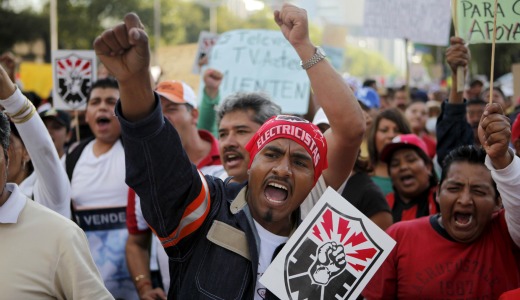
The Mexican Electrical Workers’ Union or SME (Sindicato Mexicano de Electricistas) scored a victory last week when the government agreed to recognize its leadership and release frozen union funds, in exchange for the dismantlement of a union protest camp that could have embarrassed President Felipe Calderon on Mexico’s most important national holiday, Independence Day.
In recent years, the independent, left-led SME has become the center of organizing efforts to oppose the neo-liberal policies of rigged “free” trade, privatization and the gutting of social welfare programs that are pushed by Mr. Calderon of the right-wing National Action Party. So it was not a big surprise when, in October of 2009, the government swooped down and took over all the facilities of Central Light and Power (Luz y Fuerza del Centro), the state owned company that ran electrical services for Mexico City and most of Central Mexico, for whose employees the SME was the sole bargaining agent. Control of the former Central Light and Power operations were handed over to another company, the CFE (Federal Electrical Commission), also state owned but with a union that has a reputation for passivity and even corruption.
This action set off a two-year saga involving demonstrations, arrests, slander campaigns in the media, violent attacks against union members and the refusal of the government to issue the “toma de nota” which means recognition of the election of union members, for July’s union election.
The government had frozen the union’s funds, and, earlier this summer had ordered the arrest of SME Secretary General Martin Esparza and two other officials for trying to access them. The government offered a severance package to former Central Light and Power employees who would repudiate the union, but a hard core of 16,000 SME members has continued to press demands, among others that the government, as their ultimate employer, find a “substitute employer” for them, as stipulated in Mexican law.
Meanwhile, the CFE has not been doing too well, with complaints about crazy rate increases, poor service and, more recently, the prosecution of a CFE official for his involvement in corrupt contracts with US private corporations.
One of the tactics of the SME has been a long-running “planton” in Mexico City’s main square, known as the Zocalo. The Zocalo is an iconic historic site in Mexico. It is an immense plaza, which is surrounded on one side by enormous 17th Century cathedral, on another by the official national palace, and on the other two sides by other governmental and commercial buildings. A “planton” is a long-running and very visible sit-in.
September 16th was the 201st anniversary of Mexico’s declaration of independence from Spain, and is a very important national holiday. On the evening of September 15, 1810, Father Miguel Hidalgo y Costilla proclaimed the goal of independence from the parish church in the little town of Dolores in the State of Guanajuato. This call, known as the “Grito” (the shout or cry) is variously recorded as having been just “Viva Mexico!” or “Viva Mexico, muera el mal gobierno” (Long live Mexico! Death to the bad government!) or maybe something else entirely. Every September 15, the president of Mexico steps out on the balcony of the National Palace, overlooking the Zocalo, and gives the “Grito.”
But there was the SME’s planton, right smack in the middle of the space in which thousands were supposed to gather to hear the “Grito”! The government feared that Calderon would at the very least be upstaged by shouting SME members, and that instead of a triumph, the event could turn into a major embarrassment for the government. Calderon’s people could not persuade Mexico City’s Regional Governor Marcelo Ebrard, of the leftish Revolutionary Democratic Party (PRD) to use force to dislodge the planton. So the federal government was forced to negotiate.
Out of this meeting came an agreement that the government would continue to negotiate with the SME over outstanding grievances, and the union would dismantle the planton and not disrupt the “Grito” (which went ahead with reduced attendance, possibly because of heavy rain).
But at the same time, the government delivered the coveted “toma de nota” to SME Secretary General Esparza, this recognizing the legitimacy of the union’s elections and also, implicitly, that the SME is still a bonifide labor union under Mexican law. Not only that, but it announced, also, that 21 million pesos ($1,626,000 US) of the frozen funds were now available to the union. The government denies that the “toma de nota” and the unfreezing of the funds were part of the deal to get the SME to dismantle the “planton,” but few believe this.
Negotiations will now proceed between the government and the SME about the union’s remaining demands, including the key issue of a “substitute employer.” But the issuing of the toma de nota and the unfreezing of the funds are a clear moral, political and financial victory for the SME. It is hard to see, also, how the government’s case against Esparza and his two colleagues can stand after the government has conceded that he is the actual Secretary General of the SME and that the funds he is accused of illegally trying to access are indeed property of the union.
Photo: Members of the Mexican Union of Electricians (SME) protest against the government’s decision to disband the state-run electricity company, Luz y Fuerza del Centro, in Mexico City, Oct. 15, 2009. Mexico’s President Felipe Calderon disbanded the provider that supplies electricity to central Mexico, citing a budget hole that threatened service to 25 million consumers.
(AP Photo/Eduardo Verdugo)










